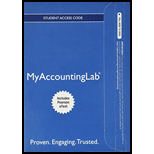
Concept Introduction:
Investment in Debt securities: Debt securities are financing instrument which represents the loan taken from lender and usually these securities pay defined interest rate on the amount borrowed. The several types of debt instruments are bonds, certificate of deposits,
1. Held to maturity: Held to maturity is a type of debt investment that the investor intends to hold till maturity. These securities are recorded at amortized cost.
2. Trading: Trading securities are purchased by the investor for the purpose to sell within a short term period to each profit. These securities are recorded at their fair value and any gain or loss in recognized in the income statement for that period.
3. Available for sale: All the other securities are considered as available for sale and these securities are recorded at their fair value and any gain or loss is recognized unrealized gain or loss until the securities are actually sold.
To indicate: The recording of gain or loss on sale on disposing off an available for sale debt investment
Want to see the full answer?
Check out a sample textbook solution
Chapter 15 Solutions
Myaccountinglab With Pearson Etext -- Access Card -- For Horngren's Accounting, The Managerial Chapters
- Can you help me solve this financial accounting question using the correct financial procedures?arrow_forwardRoslyn's Boutique had an accounts receivable balance of $320,000 at the beginning of the year and a year-end balance of $460,000. Net credit sales for the year totaled $2,800,000. What was the average collection period?arrow_forwardHarlow Co. is a merchandising company. Last month the company's cost of goods sold was $65,200. The company's beginning merchandise inventory was $12,500 and its ending merchandise inventory was $22,400. What was the total amount of the company's merchandise purchases for the month?arrow_forward
- Finn's Furniture has accounts receivable of $5,280, inventory of $2,100, sales of $152,000, and cost of goods sold of $75,600. How many days does it take the firm to sell its inventory and collect the payment on the sale assuming all sales are on credit?arrow_forwardCarlton Enterprises has the following dataarrow_forwardFinn's Furniture has accounts receivable of $5,280, inventory of $2,100, sales of $152,000, and cost of goods sold of $75,600. How many days does it take the firm to sell its inventory and collect the payment on the sale assuming all sales are on credit? Need helparrow_forward

 AccountingAccountingISBN:9781337272094Author:WARREN, Carl S., Reeve, James M., Duchac, Jonathan E.Publisher:Cengage Learning,
AccountingAccountingISBN:9781337272094Author:WARREN, Carl S., Reeve, James M., Duchac, Jonathan E.Publisher:Cengage Learning, Accounting Information SystemsAccountingISBN:9781337619202Author:Hall, James A.Publisher:Cengage Learning,
Accounting Information SystemsAccountingISBN:9781337619202Author:Hall, James A.Publisher:Cengage Learning, Horngren's Cost Accounting: A Managerial Emphasis...AccountingISBN:9780134475585Author:Srikant M. Datar, Madhav V. RajanPublisher:PEARSON
Horngren's Cost Accounting: A Managerial Emphasis...AccountingISBN:9780134475585Author:Srikant M. Datar, Madhav V. RajanPublisher:PEARSON Intermediate AccountingAccountingISBN:9781259722660Author:J. David Spiceland, Mark W. Nelson, Wayne M ThomasPublisher:McGraw-Hill Education
Intermediate AccountingAccountingISBN:9781259722660Author:J. David Spiceland, Mark W. Nelson, Wayne M ThomasPublisher:McGraw-Hill Education Financial and Managerial AccountingAccountingISBN:9781259726705Author:John J Wild, Ken W. Shaw, Barbara Chiappetta Fundamental Accounting PrinciplesPublisher:McGraw-Hill Education
Financial and Managerial AccountingAccountingISBN:9781259726705Author:John J Wild, Ken W. Shaw, Barbara Chiappetta Fundamental Accounting PrinciplesPublisher:McGraw-Hill Education





